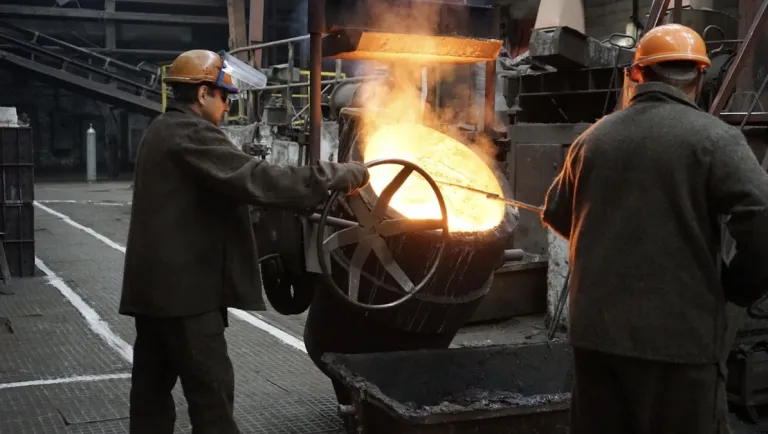
Three years after Russia’s full-scale invasion, Ukrainian industry has lost a third of its output, yet it has been demonstrating recovery for the second consecutive year.
According to official statistics, industrial production in Ukraine grew by 3.6% in 2024 after an increase of 6.8% in 2023. While this does not offset the 36.7% drop in 2022, it signals a steady trend toward revitalisation.
Based on index calculations, the industry is currently operating at about 70% of its pre-war level.
Alona Lebedieva, the owner of the Ukrainian multi-profile industrial and investment group “Aurum Group” — which operates in the sectors of mechanical engineering, pump manufacturing, engineering services, chemical industry, logistics, real estate development, and agriculture — talks about which sectors are growing, which remain in crisis, why metallurgy is leading again, why mechanical engineering and chemistry remain at risk, and what could change the rules of the game.
“Ukrainian industry is now operating at approximately 70% of pre-war levels — and this is an achievement, considering the daily challenges. We have lost a lot, but we’ve preserved the most important thing — the ability to work and adapt.” Lebedieva emphasises.
Who Drives the Economy?
“The recovery of industry is driven by several factors: demand from the military, activity in the construction sector, business relocation, export recovery, and stabilisation of the maritime corridor.
“It is difficult to accurately assess the scale of production in the defence-industrial complex due to the classified nature of some data, but it is clear that it creates a strong demand for metallurgy, chemical industry, and electronics products. Every hryvnia invested in defence multiplies across the economy, boosting the development of critical sectors.”
In 2024, ore extraction increased by 23%, steel production by 21.6%, and rolled metal output by 15.8%. Key drivers include the partial unblocking of maritime exports, and demand from the construction sector and the defence industry.
“Metallurgy is making a comeback thanks to the army and reconstruction. Armor, beams, wire rods, galvanised steel — all of this is used for armoured vehicles, bridges, and civilian facilities. This is a new multipurpose role for the sector,” Lebedieva commented.
The construction sector plays a powerful role as a consumer of metal products. According to the Ministry of Economy, in 2024, critical and residential infrastructure restoration projects were actively implemented. Every hryvnia invested in construction generates 2.5–3 hryvnias in related industries such as metallurgy, building materials manufacturing, and transport logistics.
Railway logistics, particularly long-distance freight transportation, plays a key role in ensuring a steady construction process.
The pharmaceutical industry continues to grow (+1.9%) despite complex logistics and dependence on imported components. The food industry added 6.2% over the year, due to stable domestic demand and logistics stabilisation.
Problematic Areas
Meanwhile, sectors that remain at risk include mechanical engineering (–1.2%), woodworking (–8.8%), chemical production (–9.9%), automobile manufacturing (–17%), and electronics (–19%). The main reasons are energy shortages, logistics disruptions, import dependence, and a lack of skilled labor.
“Mechanical engineering declined not because of a lack of competencies, but due to a lack of orders and access to energy resources. However, segments with government orders — such as railcar manufacturing — remain viable,” explains Alona Lebedieva.
Energy-intensive industries face particular challenges. Attacks on the power grid have forced factory shutdowns. Some businesses have switched to generators, but this model significantly increases costs and is economically unjustifiable in certain sectors. This is especially true for mechanical engineering, which consumes enormous amounts of electricity, and where replacing centralised supply with generators is usually technically impossible.
“We must be honest: stable operation of energy-intensive industries during wartime can only be ensured by powerful base electricity sources — particularly nuclear energy, which plays a key role in the country’s energy balance. It is also important to preserve and develop hydroelectric power as a reliable source for load balancing. Autonomous generation and green energy can serve as effective additional tools to smooth peak loads and increase system resilience,” Lebedieva notes.
Digital Adaptation as a Breakthrough Opportunity
Despite the apparent inertia of heavy industry, war has become a catalyst for technological change. Ukrainian manufacturers — especially in mechanical engineering and logistics — are actively implementing digital solutions, from remote equipment monitoring to automated production tracking.
Interest in Industry 4.0 is also growing: intelligent production lines, robotics, cloud-based data management. The highest demand for such solutions comes from companies working with international partners or supplying EU markets, where certification and product life-cycle traceability are mandatory.
However, innovation implementation is hampered by a lack of IT specialists in the regions, outdated infrastructure, and high costs of technological upgrades. Still, the trend is clear.
“Digital transformation is not a luxury — it’s a matter of survival. It enables cost reduction and allows companies to operate with limited access to personnel, energy, and logistics,” Lebedieva emphasises.
Investment Signals of Hope
Despite everything, new industrial projects are being launched in Ukraine. One of the most high-profile examples is the creation of a chemical hub in Rivne, which involves building plants for producing ammonia, green hydrogen, and nitrogen fertilisers.
Such projects, in Lebedieva’s opinion, change investors’ perception of Ukraine.
“Investment now is not only about profit — it’s a political signal: ‘I believe in Ukraine.’ And we must respond to this signal — with guarantees, protection, and stability,” she says.
At Aurum Group, investment continues in modernising the railcar fleet, logistics, and upgrading production facilities.
People as the Main Resource
One of the main challenges remains the workforce. After millions of Ukrainians left, were mobilised, or relocated internally, businesses face a shortage of qualified workers.
“We don’t just need labour — we need to bring back engineers, technicians, train operators. We must retrain women for traditionally male roles. And to do that, we need more than just wages — we need housing, safety, and decent conditions. A factory is not just a shop floor, it’s the community around it,” Lebedieva says.
She believes that industry can become a “magnet” for returning internally displaced persons and labour migrants — if new facilities are launched in the regions.

European Integration Through the Economy
Lebedieva believes Ukraine’s path to the EU should run through industrial integration. It’s not just about regulations and rules, but shared supply chains, certification, and cooperation.
“Ukrainian industry is not an add-on to the EU. It can be a full-fledged part of the European economy: from electric steel to fertilizers, from railcars to medicines,” she asserts.
In her view, industry can become the most resilient foundation for Ukraine’s recovery — especially if government, business, and international partners work in coordination.